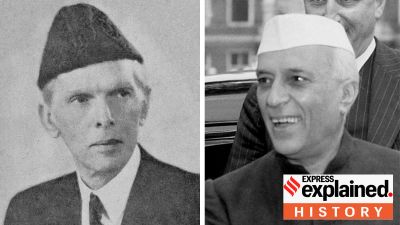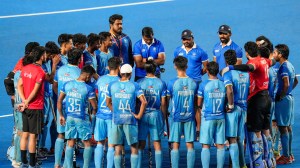Decode Politics: Why Centre’s plan for Kashi Tamil Sangamam 3.0 has reignited BJP, DMK faultline
BJP dispensation’s move to make Sage Agasthyar the KTS 3.0 focus has been seen by the Dravidian camp as a fresh bid to “appropriate” a key Tamil icon
 Tamil delegation being showered with flower petals on their arrival at Kashi Vishwanath under Kashi Tamil Sangamam, in Varanasi, in 2022. (PTI/File)
Tamil delegation being showered with flower petals on their arrival at Kashi Vishwanath under Kashi Tamil Sangamam, in Varanasi, in 2022. (PTI/File)As the third edition of the Kashi Tamil Sangamam (KTS 3.0) approaches, scheduled for February 15-24 in Uttar Pradesh’s Varanasi, the Centre has decided to honour one of Tamil Nadu’s most revered spiritual figures, Sage Agasthyar. The timing of this celebration, however, carries significant political implications, particularly given the ideological rift between the BJP-led Centre and the DMK-led Tamil Nadu government.
What is KTS?
The KTS is a cultural initiative launched by the Union Ministry of Education, which is aimed at celebrating the historical and civilisational connections between Kashi (modern-day Varanasi) and Tamil Nadu.
In November 2022, the first edition of the event took place, featuring various cultural exchanges, exhibitions, and academic discussions that showcased art, music, cuisine, and handicrafts from both regions. About 2,400 participants from Tamil Nadu attended the inaugural event.
In December 2023, the second edition of the KTS was held on the themes of cultural exchange and understanding.
Why is BJP embracing Tamil icons?
While the DMK, rooted in rationalist and anti-religious ideologies, opposes the BJP’s pitch for Hindu religious symbols, the Centre’s focus on Agasthyar has raised various questions about faith, politics, and cultural identity.
Agasthyar, a central figure in the Tamil culture and spirituality who is also recognised in Kerala, symbolises mysticism, knowledge, medicinal wisdom, and unity. The KTS 3.0 will highlight his contributions to Siddha or traditional medicine, Tamil literature, and intellectual traditions. Yet, Agasthyar’s blend of myth and history has made him a politically contested figure.
Union Education Minister Dharmendra Pradhan, while announcing the KTS 3.0, said the event was meant to connect Tamil Nadu with Kashi, both centres of Indian civilisation and culture. This year’s celebration is especially significant, coinciding with the Mahakumbh Mela in UP, allowing participants to experience Kumbh and visit the Ram Temple in Ayodhya.
While the BJP was born of a political movement with a relatively short history and lacks visible philosophical links with stalwarts of significant social movements in the South, it is keen to claim an organic affinity with all of India, leading to several initiatives to build familiarity with the cultural icons from the region.
Taking a cue from the RSS, the BJP leadership has evoked many icons from the South while it attempts to find its foot in the region. BJP leaders claimed the inaugural Sangamam found resonance with Hindus in Tamil Nadu. While the event is an initiative from the government for national integration, BJP leaders admitted that it was also an attempt to build a bridge between the party and the electorate in Tamil Nadu.
What are ideological tensions behind KTS?
For Tamil Nadu’s rationalist factions, particularly those aligned with the DMK and the Dravidar Kazhagam movement, the Centre’s celebration of Agasthyar, seen as a pillar of Tamil spiritual tradition, represents an ideological conflict. The DMK, an advocate for rationalism and secularism for long, stands at odds with the BJP’s use of Hindu religious symbolism for alleged poitical gains.
An attempt to “appropriate” a saint from the Siddha tradition could anger followers of the Dravidian ideology as Siddha medicine gained prominence in the early 20th century during the Justice Party’s socialist movement, when figures like Periyar E V Ramasamy, who fought against caste and religious hierarchies, promoted it as a genuine native medical tradition.
After the inaugural event in 2022, though Prime Minister Narendra Modi emphasised there was no political motive behind the KTS, the CPI(M), an ally of the DMK, urged the Tamil Nadu government to stop the event and accused the PM of holding it to “induct college students into the RSS” while the DMK linked the event to the issue of “Hindi imposition”.
What is Agasthyar’s role in Tamil heritage?
Engaging with the figure of Agasthyar is complex for Siddha experts, as his identity remains ambiguous. Unlike later Siddha practitioners, Agasthyar’s legacy is largely shaped by centuries of mythology. Revered in the Siddha tradition, a form of traditional medicine primarily practiced in Tamil Nadu, Agasthyar is believed to have lived and practiced in the Agasthyar Hills south of the Western Ghats, now in Kerala. His origins are debated – while some suggest he came from the north, Tamil scholars assert his deep ties to the Tamil culture.
Siddha, often compared to Ayurveda, shares common principles with both Ayurveda and Unani of Arabs, drawing from ancient exchanges of knowledge across the subcontinent. Dr G Sivaraman, a Siddha expert, said Siddha traditions reflect Tamil native knowledge, especially in their ecological and landscape focus, and counters theories of northern origins.
National Siddha Day celebrates Agasthyar’s contribution to medicine, and his birth star, Aayillyam, is recognised by the Centre. Both Siddha and Ayurveda trace their roots to Sankhya and Buddhist philosophy, though Vedic philosophies later supplanted them. The Dravidian movement promoted Siddha as a part of Tamil cultural identity, with figures like Dr Vedanayagam Pillai advocating for its recognition alongside modern medicine.
How much is Siddha medicine recognised?
While Siddha faces challenges of scientific validation, Sivaraman spoke about “the Ayush ministry’s lack of support to Tamil Nadu compared to Ayurveda,” calling for more funding and unbiased research to establish Siddha’s place in India’s healthcare system. “Ignoring Siddha’s scope and research by the Union government may be also because it is intertwined with Tamil nationalism, state’s anti-Sanskrit position, and the clashes in cultural politics,” he said.
While the Indian Medical Association does not recognise Siddha medicine, Tamil Nadu has more than a dozen Siddha medical colleges, both in the private and public sectors. The state has a Tamil Nadu Siddha Medical Council that regulates the practice and practitioners of Siddha medicine. The state government has also integrated Siddha medicine into public health by establishing Siddha wings in primary health centres and government hospitals, offering alternative treatment options and government-supplied Siddha medicinal kits, especially for pregnant and lactating women.
- 01
- 02
- 03
- 04
- 05































